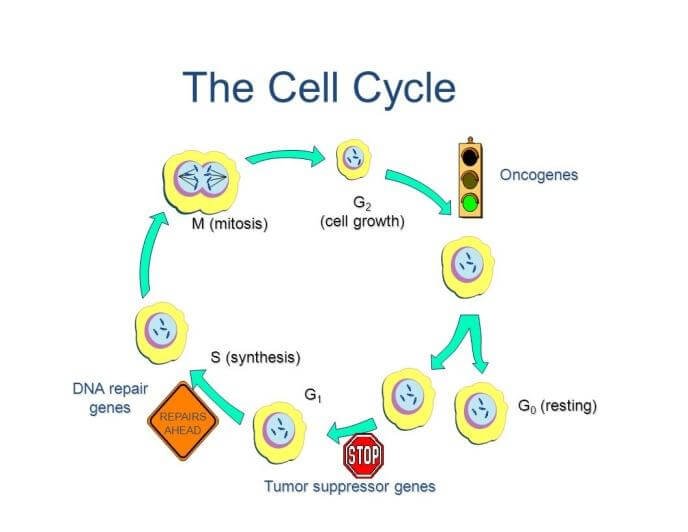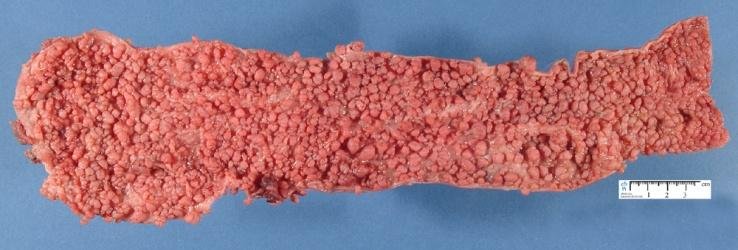Definition of Tumor suppressor genes
Tumor suppressor genes are normal genes that encode proteins who take part in cell life. Tumor suppressor genes have an inhibitory function and normally they prevent tumor growth. In case these genes are turned off, it is possible for cancer to develop [1].
How do tumor suppressor genes work?
Tumor suppressor genes encode certain proteins. These proteins take part in:
- Slowing down cell division
- Repairing mistakes in DNA
- Controlling programmed cell death- apoptosis
There are 2 main groups of tumor suppressor genes:
- Promoters- mutation of these genes directly leads to uncontrolled cell proliferation
- Caretakers-responsible for integrity of the genome. Mutation of these genes compromises their ability to repair DNA therefore causing mutations in other genes.
Human cells have 2 copies of each gene- one is inherited from the mother and other one from the father. If the cell contains at least one functioning tumor suppressor gene that can produce enough protein with inhibitory function, it will continue functioning. In order to inactivate tumor suppressor gene both copies have to be inactivated. For this reason mutations in tumor suppressor genes are recessive [1,2].

 Tumor suppressor genes and oncogenes
Tumor suppressor genes and oncogenes
Tumor suppressor genes have an inhibitory function, while proto-oncogenes are stimulating cell growth and development. When proto-oncogene is mutated or there are too many copies of it, cells start to grow uncontrollably. When this happens proto-oncogene is called oncogene. Both of these gene types take part in tumor development. The difference is that oncogenes play role in tumor development when they are activa ted, but tumor suppressor genes- when they are “switched off”[2]. 
 Tumor suppressor genes and cancer
Tumor suppressor genes and cancer
Retinoblastoma (Rb) gene
RB gene was first found in patients with inherited retinoblastoma. In 1971 Knudson hypothesized that two copies of the gene have to be dama ged for retinoblastoma to be present. His hypothesis was proven right, thus making Rb gene the first found tumor suppressor gene. This gene regulates the cell cycle by inhibiting G1 phase of cell cycle. If mutated, cells start to uncontrollably divide. This gene can be deactivated by

Retinoblastoma
- Phosphorylation (adding of phosphate group to a molecule), associated with
- B-cell lymphoma
- Squamous cell carcinoma
- Mutation, associated with:
- Familial retinoblastoma
- Osteogenic sarcoma

- Small cell lung carcinoma
- Binding of virus oncoprotein, associated with
- Cervical cancer
- Mesothelioma
- AIDS related Burkitt´s lymphoma[3]
P53 gene
P53 gene is the most frequently altered tumor suppressor gene. Deactivation of this gene can be a cause for different types of cancer by the following process:
- Mutation in DNA binding domain- this mutation prevents p53 from binding to DNA and activating adjacent genes. It is associated with
- Colon cancer
- Brest cancer
- Pancreatic cancer and many others
- Binding of viral oncogene:
- Cervical cancer
- Lymphoma
- Mislocaization of p53 outside the nucleus to the cytoplasm
- Breast cancer
- Neuroblastomas [4]
P53 gene is also associated with Li-Fraumeni syndrome. P53 gene is located in the short arm of chromosome 17, and in case of this syndrome a part of chromosome 17 with this gene is lost.
APC gene
APC (adenomatous polyposis coli) gene is m ostly known for being linked to Familial Adenomatous polyposis. APC gene is also linked to:
- Gastric cancer
- Hepatocellular carcinoma
- Hereditary desmoids disease
- Medulloblastoma[5]

![]()
BRCA1 and BRCA2 gene
BRCA1 and BRCA2 (breast cancer 1 and 2) genes encode proteins that take part in repairing DNA and interact with other proteins. These genes and their proteins also take part in regulating activity of other genes. BRCA1 gene is believed to have an important role during embryogenesis, but the mechanisms are not yet understood. BRCA2 gene and its protein help in regulation of cell division. BRCA1 and BRCA2 mutations are associated with:
- Breast cancer- if associated with BRCA1 and BRCA 2 cancer usually runs in families and has an early onset (around age of 40). Usually there is a combination of breast and ovarian cancer. Women with mutated BRCA1 gene have a 55-65% chance to develop breast cancer until 70years of age, but woman with BRC2 have a 45% chance.
- Ovarian cancer- women with BRCA1 mutation have a 40% chance to develop ovarian cancer by the age of 70, while with BRCA2 mutation the possibility is 11-17% [6].
- Prostate cancer
- Pancreatic cancer
- Colon cancer
- BRCA2 is associated with Fanconi anemia and Melanoma [7]
NF1 gene
NF1 (neurofibromatosis 1) gene encodes protein- neurofibromin. It is produced in many cells, including nerve cells, oligodendrocytes and Schwann cells that make the myelin sheath which surrounds nerve fibers. Neurofibromin is a tumor suppressor protein which suppresses an oncogene- RAS. Neurofibromin turns off the RAS oncogene which normally stimulates cell growth and division. Mutations in NF1 gene are associated with:
- Neurofibromatosis Type 1
- Juvenile myelomonocytic leukemia [8]
WT1 gene
WT1 (Wilms Tumor 1) gene encodes production of protein that takes part in the development of kidneys, ovaries (in woman) and testicles (in men). It has a role in cell development process when cells differentiate and gain a specific function. WT1 protein also has a part in programmed cell death process. WT1 protein carries out these functions by attaching to specific DNA regions and controlling activity of other genes. Mutations in WT1 gene are associated with:
- Wilms tumor- early childhood kidney cancer
- Congenital nephrotic syndrome
- Acute myeloid leukemia
- Denys-Drash syndrome
- Frasier syndrome
- Prostate cancer
- WAGR syndrome –syndrome that combines Wilms tumor, anirida (a condition of eyes), genitor-urinary system anomalies, intellectual disability.
- Lung cancer [9]
Other tumor suppressor genes
- NF2- neurofibromatosis 2 gene
- Schwann cell tumor
- Astrocytoma
- Meningioma
- TSC1- Tuberous sclerosis 1 gene
- Seizures
- Mental retardation
- Angiofibromas
- DPC4- deleted in pancreatic carcinoma, familial juvenile polyposis syndrome
- Pancreatic carcinoma
- Colon cancer
- PTEN- phosphotase and tensin homolog gene
- Cowden syndrome
- Glioma
- Breast cancer
- Thyroid cancer
- STK11- serine-threonine kinase 11
- Peutz-Jeghers Syndrome
- Breast and ovarian cancer [10]
Conclusion
Tumor suppressor genes mentioned in this article are only some of the currently known genes. They take part in many important processes of cell life, but the exact mechanisms of their action are still unknown. Genetic testing in case of cancer is important, because every case can give a new insight in the disease. Continuous research is carried out to better understand the actions of these genes and possibly find a way to prevent cancer.
If you found this article helpful, share it on social media. For your personal experience and comments use the box below.
References
- Information about tumor suppressor genes: https://www.ncbi.nlm.nih.gov/books/NBK9894/
- Tumor suppressor genes and oncogenes, their function: http://biochemistry2.ucsf.edu/programs/ptf/m3%20links/TumorSuppressLEC.pdf
- Rb gene: http://biochemistry2.ucsf.edu/programs/ptf/m3%20links/TumorSuppressLEC.pdf
- P53 gene: http://biochemistry2.ucsf.edu/programs/ptf/m3%20links/TumorSuppressLEC.pdf
- APC gene: http://www.genecards.org/cgi-bin/carddisp.pl?gene=APC
- BRCA gene and conditions: https://www.cancer.gov/about-cancer/causes-prevention/genetics/brca-fact-sheet#q2
- BRCA gene: https://ghr.nlm.nih.gov/gene/BRCA2#conditions
- NF1 gene: https://ghr.nlm.nih.gov/gene/NF1#synonyms
- WT1 gene: https://ghr.nlm.nih.gov/gene/WT1
- Other tumor suppressor genes: http://themedicalbiochemistrypage.org/tumor-suppressors.php#wt1
Similar Posts:
- Retinoblastoma
- Triple Negative Breast Cancer
- Granular Cell Tumor
- Genetic DNA Testing for Cancers
- HER2 Positive Breast Cancer
- CEA Tumor Marker
- Trichoepithelioma – Pictures, Treatment, Symptoms, Causes






Leave a Reply